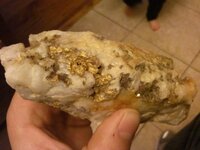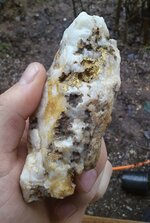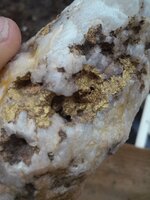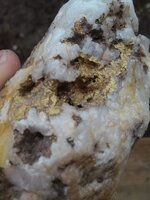Navigation
Install the app
How to install the app on iOS
Follow along with the video below to see how to install our site as a web app on your home screen.
Note: This feature may not be available in some browsers.
More options
You are using an out of date browser. It may not display this or other websites correctly.
You should upgrade or use an alternative browser.
You should upgrade or use an alternative browser.
Specimens
- Thread starter sierra_ronin
- Start date
goldenIrishman
Silver Member
- Feb 28, 2013
- 3,465
- 6,153
- Detector(s) used
- Fisher / Gold Bug AND the MK-VII eyeballs
- Primary Interest:
- Other
If it proves to go all the way through the rock, you might want to consider finding someone that can etch the rock away with acid. It looks to me like that would be a beautiful piece when and if you etch the rock away.
Amazon Forum Fav 👍
sierra_ronin
Jr. Member
- Thread starter
- #22
RIGHTEOUS species for sure. Silence is indeed golden so tell NO ONE where-John
John,
AGREED
sierra_ronin
Jr. Member
- Thread starter
- #23
If it proves to go all the way through the rock, you might want to consider finding someone that can etch the rock away with acid. It looks to me like that would be a beautiful piece when and if you etch the rock away.
It appears to be a thin sheet of gold but who knows what may be inside. I'll have a better idea after computing it's density.
arizau
Silver Member
- May 2, 2014
- 2,518
- 3,947
- Detector(s) used
- Beach High Banker, Sweep Jig, Whippet Dry Washer, Lobo ST, 1/2 width 2 tray Gold Cube, numerous pans, rocker box, and home made fluid bed and stream sluices.
- Primary Interest:
- Prospecting
If it proves to go all the way through the rock, you might want to consider finding someone that can etch the rock away with acid. It looks to me like that would be a beautiful piece when and if you etch the rock away.
Or you could ruin the specimen. If the perceived interior stringers are nonexistent or unsubstantial (wiry) you may end up with several pieces of pretty leaf gold with less value than a natural specimen. In this case I choose nature over science. With a piece of ore, say from the 16 to 1 mine in Alleghany (sp), I might choose differently if the quartz was cracked throughout but held together with gold stringers.
Last edited:
As I said in my forum post from Monday "My First Quartz Gold Specimen" I would be posting photos of my specimens over the next few weeks. Here I have some images of the second specimen I found in the heart of the mother lode near a historically productive area.
View attachment 1116909
View attachment 1116910
View attachment 1116911
View attachment 1116912
Very Nice ! How long ago did you find that ?
sierra_ronin
Jr. Member
- Thread starter
- #27
Or you could ruin the specimen. If the perceived interior stringers are nonexistent or unsubstantial (wiry) you may end up with several pieces of pretty leaf gold with less value than a natural specimen. In this case I choose nature over science. With a piece of ore, say from the 16 to 1 mine in Alleghany (sp), I might choose differently if the quartz was cracked throughout but held together with gold stringers.
This is a good point. I prefer my specimens to be intact as a rule of thumb so far. I haven't had reason to believe there are ounces hidden inside the quartz to warrant destroying the specimens to harvest it but I will do some analysis in the near future and go from there.
sierra_ronin
Jr. Member
- Thread starter
- #28
Very Nice ! How long ago did you find that ?
I found this one late 2013' or early 2014'.
Hard Prospector
Hero Member
- Aug 29, 2012
- 974
- 1,387
- Detector(s) used
- SDC2300, Gold Monster, Sierra Gold Trac, GB2, the Falcon......and just as many drywashers
- Primary Interest:
- Prospecting
Those large gold quartz specimens are nature's treasure forged by the hand of God.....I say keep or sell em' intact. Beautiful piece and well done.
sierra_ronin
Jr. Member
- Thread starter
- #30
Those large gold quartz specimens are nature's treasure forged by the hand of God.....I say keep or sell em' intact. Beautiful piece and well done.
I would have to agree. Thanks
BurntBear
Bronze Member
- Jul 4, 2014
- 1,450
- 1,303
- Detector(s) used
- Shovels....lots of shovels!
- Primary Interest:
- Other

If you could; I would dig the crap out of that area.
Last edited:
huntsman53
Gold Member
If you could; I would dig the crap out of that area.
Yeah, like most of us prospectors, we have to dig the crap out of a spot to get to the Gold, LOL!!
Frank
Peyton Manning
Gold Member
- Dec 19, 2012
- 14,629
- 18,954
- 🏆 Honorable Mentions:
- 1
- Detector(s) used
- MXT-PRO
Sandshark
- Primary Interest:
- Metal Detecting
those mixed with quartz like that I usually don't pick up
I only collect the solid nuggets
(ok, not really) Yours is cool
I only collect the solid nuggets
(ok, not really) Yours is cool
huntsman53
Gold Member
- Jan 1, 2013
- 2,657
- 5,431
- Detector(s) used
- Tesoro Vaquero, Whites MXT, Vsat, GMT, 5900Di Pro, Minelab GPX 5000, GPXtreme, 2200SD, Excalibur 1000!
- Primary Interest:
- All Treasure Hunting
The problem is this... You can't use any specific gravity test on your nugget because it's not pure quartz and gold. You can easily see the other mineralization throughout the quartz. The specific gravity test is weighing all of the metals inside and outside, not just the gold and quartz so this speci unfortunately will not be accurate. But there is another way to look at it and that is that even though there may be very little gold inside this specimen, most people don't know that the specimen has to be pure quartz and gold to get an accurate reading. I would guess that 75% of the weight after the test will actually be iron and the other metals inside this specimen, so if you do the test and it will come out really high in metal content that many will think is gold, an unsuspecting buyer wanting to pay you on gold content will pay a lot more for it then its actual weight if they have never seen the truth about this calculation. The only way to know for sure would be to crush it and then weigh all of the minerals separately. I have a mineralized nugget that I am going to crush for a specific gravity video one of these days to demonstrate exactly what I am saying for everyone and I will try to get it done this Spring 

- Jul 27, 2006
- 49,427
- 57,646
- Detector(s) used
- Minelab_Equinox_ 800 Minelab_CTX-3030 Minelab_Excal_1000 Minelab_Sovereign_GT Minelab_Safari Minelab_ETrac Whites_Beach_Hunter_ID Fisher_1235_X
- Primary Interest:
- All Treasure Hunting
Really nice eyeball find..
sierra_ronin
Jr. Member
- Thread starter
- #37
The problem is this... You can't use any specific gravity test on your nugget because it's not pure quartz and gold. You can easily see the other mineralization throughout the quartz. The specific gravity test is weighing all of the metals inside and outside, not just the gold and quartz so this speci unfortunately will not be accurate. But there is another way to look at it and that is that even though there may be very little gold inside this specimen, most people don't know that the specimen has to be pure quartz and gold to get an accurate reading. I would guess that 75% of the weight after the test will actually be iron and the other metals inside this specimen, so if you do the test and it will come out really high in metal content that many will think is gold, an unsuspecting buyer wanting to pay you on gold content will pay a lot more for it then its actual weight if they have never seen the truth about this calculation. The only way to know for sure would be to crush it and then weigh all of the minerals separately. I have a mineralized nugget that I am going to crush for a specific gravity video one of these days to demonstrate exactly what I am saying for everyone and I will try to get it done this Spring
I've considered this myself, you just cant be sure of the average SG of the non gold minerals in the piece. I will be eagerly awaiting your video.
sierra_ronin
Jr. Member
- Thread starter
- #38
I've been busy with school and working side jobs to keep the bills paid but for completeness sake I will share some photos of my last two gold in quartz specimens.
These are my largest two specimens. One is a fairly large piece of quartz with one streak of gold running horizontally across the surface. The smaller of the two pieces is probably my favorite with several small and very thin gold sheets scattered over the surface of the quartz. In some photos I've added a baseball in the picture frame for some perspective on the size of these pieces. Please excuse the bad lighting.
The larger of the two:
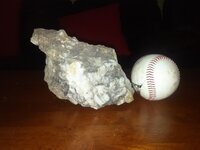
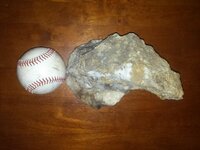
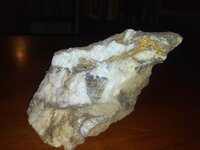
My Fave:
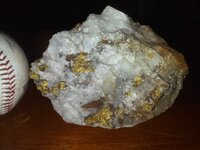
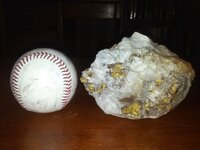
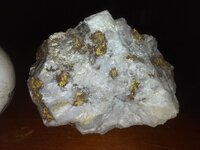
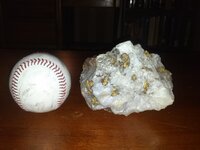
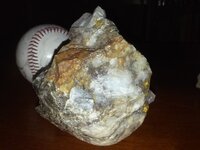
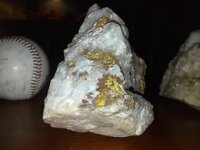
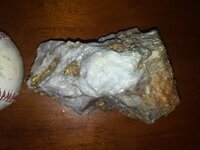
And as always heavy pans.
These are my largest two specimens. One is a fairly large piece of quartz with one streak of gold running horizontally across the surface. The smaller of the two pieces is probably my favorite with several small and very thin gold sheets scattered over the surface of the quartz. In some photos I've added a baseball in the picture frame for some perspective on the size of these pieces. Please excuse the bad lighting.
The larger of the two:



My Fave:







And as always heavy pans.
huntsman53
Gold Member
Man, you are finding some awesome specimens! If it were me, I would have already taken down the mountains and dug a hole to China to find the source. I wish I could find specimens like those on my Gold prospecting trips!
Frank
Frank
sierra_ronin
Jr. Member
- Thread starter
- #40
OK so after a good deal of head scratching and frustration I have completed some rough calculations for the weight of gold in my quartz specimens. A common equation given for calculating weight of gold in quartz is listed in figure 1:
Figure 1: Wg = (Wsa * A) - (Ww * A * B)
With Variables Defined as:
Wg = Weight of gold in object
Wsa = Weight of specimen in air, in other words the dry weight
Ww = Weight of specimen while suspended in water, also known as the wet weight
A = Sg/(Sg -So) Sg = Specific gravity of gold So = Specific gravity of other object, in this case it is quartz
B = So
A word about Sg and So:
Now first of all to reduce some confusion specific gravity and density are interchangeable values in this equation, specific gravity is just unitless. Second the values that are given by most sources for determining weight of gold in a piece of quartz will give you a value of 18.6 for specific gravity of gold and 2.65 for specific gravity of quartz. The value given for quartz ended up giving me a quite a bit of frustration.
In finding the overall densities of my specimens I found that they had densities in the range of 2.53g/cm^3 to 2.57g/cm^3. These density include not only quartz and gold but whatever additional trace minerals that may be present in each specimen. So by trying to solve the Wg equation in figure 1 above using the average specific gravity of quartz value of 2.65, I was shooting myself in the foot. I kept getting negative values for Wg when using 2.65 for "So" (specific gravity of other). I gave it some more thought and came to the conclusion that if the total average density of my whole specimens were 2.53-2.57 g/cm^3 then the density/specific gravity of the quartz and trace minerals individually must be a value less than 2.53-2.57. The reasoning behind this is that the gold in the specimens increases the total average density of the specimens.
With these things in mind I went back through the Wg calculations for each of the specimens and changed the "So" value to an arbitrary value of 2.5. I have listed the calculations below:
Specimen 1:
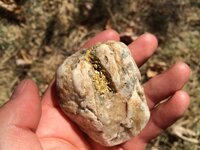
m = 118.6g
v= 46.2cm^3
D= 2.56709g/cm^3
Wg = (Wsa * A) - ( Ww * A * B) A = Sg/(Sg - So) = 18.6/(18.6-2.5) = 186/161 or 1.15527... , B = 2.5 , A*B = 465/161 or 2.88819...
Wg = (118.6g * (186/161)) - (46.2g *(465/161))
Wg = 3.58g
Specimen 2:
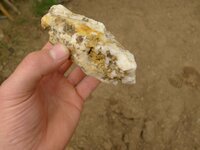
m = 293g
v = 116g/cm^3
D= 2.52586g/cm^3
Wg = (Wsa * A) - ( Ww * A * B)
Wg = (293g * (186/161)) - (116g * (465/161))
Wg = 3.46583g
Specimen 3:
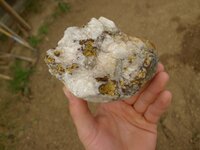
m = 720g
v = 280cm^3
D = 2.57142g/cm^3
Wg = (Wsa * A) - ( Ww * A * B)
Wg = (720g * (186/161)) - (280g * (465/161))
Wg = 23.10559g
Specimen 4:
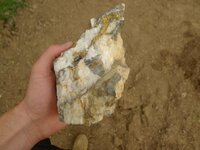
m = 1530g
v = 596g
D = 2.56711g/cm^3
Wg = (Wsa * A) - ( Ww * A * B)
Wg = (1530g * (186/161)) - (596g * (465/161))
Wg = 46.21118g
After looking over these numbers again the specific gravity/density estimation may not be the best fit for every specimen. This estimation may be too high for the Specimen 2 which has a total average density around 2.53 and it may be too low for the other specimens which have total average densities around 2.57. Regardless I think this is a descent ballpark estimation of gold content.
I encourage critiques of the methodology used here! Please let me know if you find any errors. Thanks
Figure 1: Wg = (Wsa * A) - (Ww * A * B)
With Variables Defined as:
Wg = Weight of gold in object
Wsa = Weight of specimen in air, in other words the dry weight
Ww = Weight of specimen while suspended in water, also known as the wet weight
A = Sg/(Sg -So) Sg = Specific gravity of gold So = Specific gravity of other object, in this case it is quartz
B = So
A word about Sg and So:
Now first of all to reduce some confusion specific gravity and density are interchangeable values in this equation, specific gravity is just unitless. Second the values that are given by most sources for determining weight of gold in a piece of quartz will give you a value of 18.6 for specific gravity of gold and 2.65 for specific gravity of quartz. The value given for quartz ended up giving me a quite a bit of frustration.
In finding the overall densities of my specimens I found that they had densities in the range of 2.53g/cm^3 to 2.57g/cm^3. These density include not only quartz and gold but whatever additional trace minerals that may be present in each specimen. So by trying to solve the Wg equation in figure 1 above using the average specific gravity of quartz value of 2.65, I was shooting myself in the foot. I kept getting negative values for Wg when using 2.65 for "So" (specific gravity of other). I gave it some more thought and came to the conclusion that if the total average density of my whole specimens were 2.53-2.57 g/cm^3 then the density/specific gravity of the quartz and trace minerals individually must be a value less than 2.53-2.57. The reasoning behind this is that the gold in the specimens increases the total average density of the specimens.
With these things in mind I went back through the Wg calculations for each of the specimens and changed the "So" value to an arbitrary value of 2.5. I have listed the calculations below:
Specimen 1:

m = 118.6g
v= 46.2cm^3
D= 2.56709g/cm^3
Wg = (Wsa * A) - ( Ww * A * B) A = Sg/(Sg - So) = 18.6/(18.6-2.5) = 186/161 or 1.15527... , B = 2.5 , A*B = 465/161 or 2.88819...
Wg = (118.6g * (186/161)) - (46.2g *(465/161))
Wg = 3.58g
Specimen 2:

m = 293g
v = 116g/cm^3
D= 2.52586g/cm^3
Wg = (Wsa * A) - ( Ww * A * B)
Wg = (293g * (186/161)) - (116g * (465/161))
Wg = 3.46583g
Specimen 3:

m = 720g
v = 280cm^3
D = 2.57142g/cm^3
Wg = (Wsa * A) - ( Ww * A * B)
Wg = (720g * (186/161)) - (280g * (465/161))
Wg = 23.10559g
Specimen 4:

m = 1530g
v = 596g
D = 2.56711g/cm^3
Wg = (Wsa * A) - ( Ww * A * B)
Wg = (1530g * (186/161)) - (596g * (465/161))
Wg = 46.21118g
After looking over these numbers again the specific gravity/density estimation may not be the best fit for every specimen. This estimation may be too high for the Specimen 2 which has a total average density around 2.53 and it may be too low for the other specimens which have total average densities around 2.57. Regardless I think this is a descent ballpark estimation of gold content.
I encourage critiques of the methodology used here! Please let me know if you find any errors. Thanks
Last edited:
Top Member Reactions
-
 3505
3505 -
 2080
2080 -
 2001
2001 -
 1150
1150 -
 1143
1143 -
 923
923 -
 840
840 -
 811
811 -
 808
808 -
 782
782 -
 759
759 -
 535
535 -
 511
511 -
 464
464 -
 450
450 -
 422
422 -
 415
415 -
E
414
-
 410
410 -
 406
406
Users who are viewing this thread
Total: 2 (members: 0, guests: 2)
